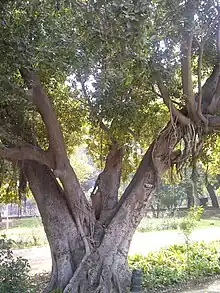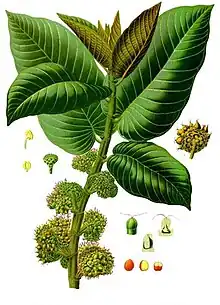Moraceae
The Moraceae — often called the mulberry family or fig family — are a family of flowering plants comprising about 38 genera and over 1100 species.[2] Most are widespread in tropical and subtropical regions, less so in temperate climates; however, their distribution is cosmopolitan overall. The only synapomorphy within the Moraceae is presence of laticifers and milky sap in all parenchymatous tissues, but generally useful field characters include two carpels sometimes with one reduced, compound inconspicuous flowers, and compound fruits.[3] The family includes well-known plants such as the fig, banyan, breadfruit, jackfruit, mulberry, and Osage orange. The 'flowers' of Moraceae are often pseudanthia (reduced inflorescences).

| Moraceae Temporal range: Cretaceous - Recent | |
|---|---|
 | |
| Panama rubber tree (Castilla elastica) | |
| Scientific classification | |
| Kingdom: | Plantae |
| Clade: | Tracheophytes |
| Clade: | Angiosperms |
| Clade: | Eudicots |
| Clade: | Rosids |
| Order: | Rosales |
| Family: | Moraceae Gaudich.[1] |
| Genera | |
|
See text | |
Description
Overall
The family varies from colossal trees like the Indian Banyan (Ficus benghalensis) which can cover five acres (two hectares) of ground, to Dorstenia barnimiana which is a small stemless, bulbous succulent 2 - 5 cm in diameter that produces a single peltate leaf on a 4 - 15 cmpetiole. These two species have an approximately one billion fold difference in weight. [4] [5]
Flowers
The individual flowers are often small, with single whorled or absent perianth. Most flowers have either petals or sepals, but not both, known as monochlamydeae, and have pistils and stamens in different flowers, known as diclinous. Except for Brosimum gaudichaudii and Castilla elastica, the perianth in all species of the Moraceae contain sepals. If the flower has an inflexed stamen, then pollen is released and distributed by wind dispersal; however, if the stamen is straight, then insect pollination is most likely to occur. Insect pollination occurs in Antiaropsis, Artocarpus, Castilla, Dorstenia, Ficus, and Mesogyne.[6]
Leaves
The leaves are much like the flowers when analyzing diversity. The leaves can be singly attached to the stem or alternating, they may be lobed or unlobed, and can be evergreen or deciduous depending on the species in question. The red mulberry can host numerous leaf types on the same tree. Leaves can be both lobed and unlobed and appear very different, but coexist on the same plant.[7]
Fruits and seeds
Plant species in the Moraceae are best known for their fruits. Overall, most species produced a fleshy fruit containing seeds. Examples include the breadfruit from Artocarpus altillis, the mulberry from Morus rubra, the fig from Ficus carica, and the jackfruit from Artocarpus heterophyllus.[8][9]
Taxonomy
Formerly included within the now defunct order Urticales, recent molecular studies have resulted in the family's placement within the Rosales in a clade called the urticalean rosids that also includes Ulmaceae, Celtidaceae, Cannabaceae, and Urticaceae. Cecropia, which has variously been placed in the Moraceae, Urticaceae, or their own family, Cecropiaceae, is now included in the Urticaceae.[10]
Dioecy (having individuals with separate sexes) appears to be the primitive state in Moraceae.[8] Monoecy has evolved independently at least four times within the family.
Phylogeny
Modern molecular phylogenetics suggest these relationships:[10][8][9][11]
| ||||||||||||||||||||||||||||||||||||||||||||||||||||||||||||||||||||||||||||||||||||||||||||||||||||||||||||||||||||||||||||||||||||||||||||||||||||||||||||||||||||||||||||||||||||||||||||||||||||||||||
Tribes and genera
Moraceae is comprised of six extant subfamiles and several tribes:[12]
- Artocarpeae Lam. & DC. 1806
- Artocarpus J.R.Forst. & G.Forst. (c. 50 spp.)
- Batocarpus H.Karst. (4 spp.)
- Clarisia Ruiz & Pav. (3 spp.)
- Hullettia King ex Hook.f. (2 spp.)
- Parartocarpus Baill. (3 spp.)
- Prainea King ex Hook.f. (4 spp.)
- Treculia Decne. ex Trécul (3 spp.)
- Castilleae C.C.Berg 1977
- Antiaropsineae (C.C.Berg) Clement & Weiblen 2005
- Antiaropsis K.Schum. (1 sp.)
- Sparattosyce Bur. (1 sp.)
- Castillineae Clement & Weiblen 2009
- Antiaris Lesch. (1 sp.)
- Castilla Cerv. (3 spp.)
- Helicostylis Trécul (7 spp.)
- Maquira Aubl. (5 spp.)
- Mesogyne Engl. (1 sp.)
- Naucleopsis Miq. (c. 20 spp.)
- Perebea Aubl. (9 spp.)
- Poulsenia Eggers (1 sp.)
- Pseudolmedia Trécul (c. 9 spp.)
- Antiaropsineae (C.C.Berg) Clement & Weiblen 2005
- Dorstenieae Dumort. 1830
- Bleekrodea Blume (3 spp.)
- Bosqueiopsis De Wild. & T.Durand (1 sp.)
- Brosimum Sw. (13 spp.)
- Broussonetia L’Hér. ex Vent. (8 spp.)
- Dorstenia L. (c. 105 spp.)
- Fatoua Gaudich. (3 spp.)
- Helianthostylis Baill. (2 spp.) – synonym of Brosimum
- Malaisia Blanco 1837 (1 sp.)
- Scyphosyce Baill. (2 spp.)
- Sloetia Teijsm. & Binn. ex Kurz 1864 (1 sp.)
- Trilepisium Thouars (1 sp.)
- Trymatococcus Poepp. & Endl. (2 spp.) – synonym of Brosimum
- Utsetela Pellegr. (1 sp.)
- Ficeae Gaudich. 1830
- Ficus L. (750 spp.)
- Maclureae W.L. Clement & Weiblen 2009
- Maclura Nutt. (11 spp.)
- Moreae Dumort. 1829
Other genera accepted by Plants of the World Online as of February 2023:
- Afromorus E.M.Gardner
- Allaeanthus Thwaites
- Ampalis Bojer
- Antiaropsis K.Schum.
- Brosimum Sw.
- Calaunia Gudzins.
- Castilla Cerv.
- Hijmania M.D.M.Vianna
- Maillardia Frapp. ex Duch.
- Maquira Aubl.
- Olmedia Ruiz & Pav.
- Paratrophis Blume
- Pseudostreblus Bureau
- Sloetiopsis Engl.
- Sparattosyce Bureau
- Taxotrophis Blume
Fossil genera and species
In addition to the living species, a number of fossil genera have been ascribed to the family:[13]
- †Aginoxylon Dupéron, 1977
- Aginoxylon moroides Dupéron, 1977
- †Artocarpidium Unger, 1850
- †Artocarpoides Saporta, 1865
- †Arthmiocarpus Delevoryas, 1964
- †Artocarpoxylon Prakash & Lalitha, 1978
- †Becktonia M. Chandler, 1961
- †Becktonia hantonensis M. Chandler, 1961
- †Cornerocarpon Grote, 2013
- †Cornerocarpon copiosum Grote, 2013
- †Coussapoites Pons, 1976
- †Coussapoites veracruzianus Pons, 1976
- †Cudranioxylon Dupéron-Laudoueneix, 1980
- †Cudranioxylon engolismense Dupéron-Laudoueneix, 1980
- †Ficofolium Peters, 1963
- †Ficofolium weylandii Peters, 1963
- †Ficonium Ettingshausen, 1883
- †Ficonium nitidum Paterson, 1934
- †Ficonium silesiacum (Velenovský) Halamski & J. Kvaček, 2015
- †Ficonium solanderi Ettingshausen, 1883
- †Milicioxylon Shukla, Mehrotra, & Guleria, 2012
- †Milicioxylon kachchhense Shukla, Mehrotra, & Guleria, 2012
- †Moraceoipollenites Zheng, 1999
- †Moricites Krüger, 1825
- †Moroidea M. Chandler, 1957
- †Moroidea baltica Dorofeev, 1982
- †Moroidea caucasica Dorofeev, 1982
- †Moroidea cretacea Knobloch & Mai, 1986
- †Moroidea hordwellensis M. Chandler, 1961
- †Moroidea reticulata Dorofeev, 1963
- †Moroidea tymensis Dorofeev, 1963
- †Moroxylon Selmeier, 1993
- †Myrianthoxylon Koeniguer, 1978
- Myrianthoxylon chaloneri Koeniguer, 1978
- †Ovicarpum M. Chandler, 1962
- †Palaeokalopanax Fotjanova, 1984
- †Palaeokalopanax kamtschaticus Fotjanova, 1984
- †Palaeokalopanax vollosovitschii Chelebaeva, 2005
- †Paleoficus Biswas
- †Protoficus Saporta, 1868
- †Protoficus crenulata Saporta, 1868
- †Protoficus crispans Langeron, 1900
- †Protoficus dentatus Langeron, 1899
- †Protoficus insignis Saporta, 1868
- †Protoficus lacera Saporta, 1868
- †Protoficus nervosa Newberry, 1883
- †Protoficus saportae Principi, 1916
- †Protoficus sezannensis (Watelet) Saporta, 1868
- †Soroceaxylon Franco, 2010
- Soroceaxylon entrerriense Franco, 2010
- †Ungerites Schleiden, 1855 (syn Ficoxylon)
- †Ungerites tropicus Schleiden, 1855
- †Welkoetoxylon Boonchai, Manchester, & Wheeler, 2015
- †Welkoetoxylon multiseriatum Boonchai, Manchester, & Wheeler, 2015
Distribution
Moraceae can be found throughout the world with a cosmopolitan distribution, thought to be due to the breakup of Gondwana during the Jurassic period.[14] The majority of species originate in the Old World tropics, particularly in Asia and the Pacific islands.[15]
References
- Angiosperm Phylogeny Group (2009). "An update of the Angiosperm Phylogeny Group classification for the orders and families of flowering plants: APG III" (PDF). Botanical Journal of the Linnean Society. 161 (2): 105–121. doi:10.1111/j.1095-8339.2009.00996.x. Retrieved 2013-07-06.
- Christenhusz, M. J. M.; Byng, J. W. (2016). "The number of known plants species in the world and its annual increase". Phytotaxa. 261 (3): 201–217. doi:10.11646/phytotaxa.261.3.1.
- Judd WS, Campbell CS, Kellogg EA, Stevens PF, Donoghue MJ (2008). Plant Systematics: A Phylogenetic Approach. Sunderland, MA: Sinauer Associates, Inc. pp. 1–620. ISBN 978-0-878-93407-2.
- Andrews, F.W. D.Sc. (1952). The Flowering Plants of the Anglo-Egyptian Sudan - Volume 2. Arbroath, Scotland: T. Buncle and Co. p. 260.
- Thulin, M. et al. (2008). Flora of Somalia, Vol. 1-4 https://plants.jstor.org/collection/FLOS
- Leite VG, Mansano VF, Teixeira SP (2018). "Floral Development of Moraceae species with emphasis on the perianth and androecium". Flora. 240 (Flora): 116–132. doi:10.1016/j.flora.2018.01.009.
- TWC Staff (2018). "Morus rubra (Red Mulberry)". Wildflower.org.
- Datwyler SL, Weiblen G (2004). "On the origin of the fig: Phylogenetic relationships of Moraceae from ndhF sequences". American Journal of Botany. 91 (5): 767–777. doi:10.3732/ajb.91.5.767. PMID 21653431.
- Clement WL, Weiblen GD (2009). "Morphological evolution in the mulberry family (Moraceae)". Systematic Botany. 34 (3): 530–552. doi:10.1600/036364409789271155. S2CID 85680800.
- Sytsma KJ, Morawetz J, Pires C, Nepokroeff M, Conti E, Zjhra M, Hall JC, Chase MW (2002). "Urticalean rosids: Circumscription, rosid ancestry, and phylogenetics based on rbcL, trnL–F, and ndhF sequences" (PDF). American Journal of Botany. 89 (9): 1531–1546. doi:10.3732/ajb.89.9.1531. PMID 21665755.
- Zerega NJ, Clement WL, Datwyler SL, Weiblen GD (2005). "Biogeography and divergence times in the mulberry family (Moraceae)". Molecular Phylogenetics and Evolution. 37 (2): 402–416. CiteSeerX 10.1.1.418.1442. doi:10.1016/j.ympev.2005.07.004. PMID 16112884.
- Hepworth C (2018). "Moraceae - The Mulberry Family". Florida Fruit Geek.
- "Moraceae". The International Fossil Plant Names Index. Retrieved 9 Feb 2023.
- "Gondwana". Encyclopedia Britannica.
- Zerega NJC, Clement WL, Datwyler SL, Weiblen GD (2005). "Biogeography and Divergence times in the mulberry family (Moraceae)". Molecular Phylogenetics and Evolution. 37 (2): 402–416. CiteSeerX 10.1.1.418.1442. doi:10.1016/j.ympev.2005.07.004. PMID 16112884.
{{cite journal}}: CS1 maint: multiple names: authors list (link)